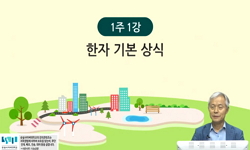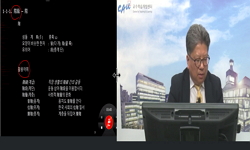Chinese characters in Korea and China has been changed and differentiated in various shapes. This fact through the resources can be concluded as follows. First of all, this classification based on a comparative way shows the radical difference between...
http://chineseinput.net/에서 pinyin(병음)방식으로 중국어를 변환할 수 있습니다.
변환된 중국어를 복사하여 사용하시면 됩니다.
- 中文 을 입력하시려면 zhongwen을 입력하시고 space를누르시면됩니다.
- 北京 을 입력하시려면 beijing을 입력하시고 space를 누르시면 됩니다.
https://www.riss.kr/link?id=A100295006
- 저자
- 발행기관
- 학술지명
- 권호사항
-
발행연도
2011
-
작성언어
Korean
- 주제어
-
KDC
800
-
등재정보
KCI등재
-
자료형태
학술저널
- 발행기관 URL
-
수록면
193-223(31쪽)
-
KCI 피인용횟수
2
- 제공처
-
0
상세조회 -
0
다운로드
부가정보
다국어 초록 (Multilingual Abstract)
Chinese characters in Korea and China has been changed and differentiated in various shapes. This fact through the resources can be concluded as follows. First of all, this classification based on a comparative way shows the radical difference between two countries. Although they used the same type of chinese characters from the ancient ages in Shang-dynasty till 1935, each country has been changed in using the type of chinese characters. In Korea, there is a policy on the usage of Korean language without chinese characters after the liberation from Japanese colonial rule. Shapes of chinese characters in Korea had no time at all to be changed because they could not be used. Chinese characters could not help being consistent in a traditional form. However, in China, there is a policy on the usage in language to use in the simplified forms in chinese characters as well as to put so many different types of chinese letters with the same meaning in order. This is why chinese characters have been shaped in a simple present form. Second, the cause in transformations can be derived from the analysis on the meaning in many different shapes of chinese characters between two countries. In Korea, the shapes in chinese letters can be consistently used. For example, these characters, ‘么’, ‘麽’ and ‘麽’ still has been used now as same as before. Comparative from Korea, chinese characters in China had been rearranged due to the situation as chinese society developed and proceeded in a various aspects. For example, the letter of ‘么’ was divided into ‘么’, ‘麽’ and ‘麽’, but again divided into ‘么’, ‘麽’, ‘么’ and ‘末’ later on. After 1986, this division has been concluded as ‘么’, ‘麽’ and ‘么’. Language is generally considered as having the culture and thoughts of people and their country, but it has been altered since 1935 in China. It is possible for language not only to be transformed for the effective way of communication, but also to be artificially modulated by terms of the demand and necessity of society. The proof of this feature can be easily seen when we usually find out the changes for more practical and drastic usage of language.
목차 (Table of Contents)
- Ⅰ. 서론 Ⅱ. 한자의 자형 Ⅲ. 한·중 한자 자형의 분류 Ⅳ. 한·중 다형자의 형의분석 Ⅴ. 자형의 출현 시기 Ⅵ. 결론 인용문헌 Abstract
- Ⅰ. 서론 Ⅱ. 한자의 자형 Ⅲ. 한·중 한자 자형의 분류 Ⅳ. 한·중 다형자의 형의분석 Ⅴ. 자형의 출현 시기 Ⅵ. 결론 인용문헌 Abstract
참고문헌 (Reference)
1 이규갑, "현대한자학" 학고방 2007
2 민중서림편집국, "한한대자전" 민중서림 2010
3 단국대학교 동양학연구소, "한한대사전 제3권" 단국대학교출판부 2000
4 단국대학교 동양학연구소, "한한대사전 제15권" 단국대학교출판부 2008
5 장삼식, "한한대사전" 교육도서 1990
6 이돈주, "한자학총론" 박영사 2004
7 김용걸, "한자자형의 세계" 성신여자대학교 출판부 2002
8 박정애, "한국한문교육용기초한자와 중국현대한어상용한자비교연구" 단국대학교대학원 2005
9 정미경, "한·중 양국의 기본 상용한자 비교 연구" 한신대학교교육대학원 2001
10 정우상, "한·중 속자 연구" 23 : 1990
1 이규갑, "현대한자학" 학고방 2007
2 민중서림편집국, "한한대자전" 민중서림 2010
3 단국대학교 동양학연구소, "한한대사전 제3권" 단국대학교출판부 2000
4 단국대학교 동양학연구소, "한한대사전 제15권" 단국대학교출판부 2008
5 장삼식, "한한대사전" 교육도서 1990
6 이돈주, "한자학총론" 박영사 2004
7 김용걸, "한자자형의 세계" 성신여자대학교 출판부 2002
8 박정애, "한국한문교육용기초한자와 중국현대한어상용한자비교연구" 단국대학교대학원 2005
9 정미경, "한·중 양국의 기본 상용한자 비교 연구" 한신대학교교육대학원 2001
10 정우상, "한·중 속자 연구" 23 : 1990
11 전광진, "한·중 단음절 한자어 대비연구" 성균관대학교 2002
12 맹뢰, "중한한자자형비교와 그 원류고찰" 건국대학교대학원 2009
13 류동춘, "중국어학개론" 한국방송통신대학출판부 2008
14 주조모, "중국문자훈고학사전" 동문선 2003
15 강윤옥, "중국 고문자학의 이해" 현학사 2005
16 주니나, "중 한 일 삼국 상용한자에 대한 비교연구" 한남대학교대학원 2007
17 혜림, "일체경음의" 동국대역경원 2003
18 혜림, "일체경음의" 동국대역경원 2000
19 혜림, "일체경음의" 동국대역경원 2003
20 혜림, "일체경음의" 동국대역경원 2003
21 혜림, "일체경음의" 동국대역경원 2004
22 혜림, "일체경음의" 동국대역경원 2000
23 장원주, "우리나라 한자교육정책에 관한 연구" 이화여자대학교교육대학원 1991
24 민중서림편집국, "엣센스 국어사전" 민중서림 1999
25 등원초수, "서도육체대자전" 이상사 1975
26 복견충경, "서도대자전 상" 교육출판공사 1998
27 한용수, "다음자(多音字)에 대한 한·중 대조비교" 한중인문학회 (31) : 347-369, 2010
28 권지용, "국제실용한자명해" 수지서림 1985
29 남광우, "고금한한자전" 인하대학교출판부 1995
30 汤可敬, "说文解字今释 (上․下)" 岳麓书社 2006
31 〔漢〕許慎撰, "說文解字注" 上海古籍出版社 2006
32 李乐毅, "简化字源" 华语教学出版社 1999
33 北京语言学院语言教学研究所, "现代汉语频率词典" 北京语言学院出版社 1986
34 中国社会科学院语言研究所词典编辑室, "现代汉语词典" 商务印书馆 2009
35 李行健, "现代汉语应用规范手册" 西海出版社 2003
36 黄伯荣, "现代汉语(上冊)" 高等教育出版社 2006
37 黄德宽, "汉语文字学史" 安徽敎育出版社 2006
38 晁继周, "汉语学习词典" 江西敎育出版社 1999
39 赵丽明, "汉字的应用与传播" 华语教育出版社 2000
40 曹先擢, "汉字形仪分析字典" 北京大学出版社 2000
41 谢光辉, "常用汉字图解" 北京大学出版社 1999
42 「历代碑帖书选」 编辑组, "唐李邕麓山寺碑" 文物出版社 1995
43 向光忠, "中华成语大辞典" 吉林文史出版社 2005
44 〔漢〕許慎撰, "『說文解字』·附檢字" 中華書局 2007
동일학술지(권/호) 다른 논문
-
- 한국동서비교문학학회
- 김영지(Kim, Young Ji)
- 2011
- KCI등재
-
Rich Dad Poor Dad와 중국어 번역본·한국어 번역본의 비교 분석
- 한국동서비교문학학회
- 백수진(Baek, Su Jin)
- 2011
- KCI등재
-
- 한국동서비교문학학회
- 서명수(Suh, Myung Soo)
- 2011
- KCI등재
-
- 한국동서비교문학학회
- 설태수(Sul, Taesoo)
- 2011
- KCI등재
분석정보
인용정보 인용지수 설명보기
학술지 이력
| 연월일 | 이력구분 | 이력상세 | 등재구분 |
|---|---|---|---|
| 2027 | 평가예정 | 재인증평가 신청대상 (재인증) | |
| 2021-01-01 | 평가 | 등재학술지 유지 (재인증) |  |
| 2018-01-01 | 평가 | 등재학술지 유지 (등재유지) |  |
| 2015-01-01 | 평가 | 등재학술지 유지 (등재유지) |  |
| 2011-01-01 | 평가 | 등재학술지 유지 (등재유지) |  |
| 2009-01-01 | 평가 | 등재학술지 유지 (등재유지) |  |
| 2006-01-01 | 평가 | 등재학술지 선정 (등재후보2차) |  |
| 2005-01-01 | 평가 | 등재후보 1차 PASS (등재후보1차) |  |
| 2003-07-01 | 평가 | 등재후보학술지 선정 (신규평가) |  |
학술지 인용정보
| 기준연도 | WOS-KCI 통합IF(2년) | KCIF(2년) | KCIF(3년) |
|---|---|---|---|
| 2016 | 0.56 | 0.56 | 0.55 |
| KCIF(4년) | KCIF(5년) | 중심성지수(3년) | 즉시성지수 |
| 0.5 | 0.45 | 1.007 | 0.18 |




 DBpia
DBpia






